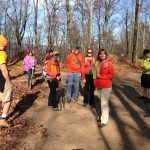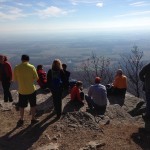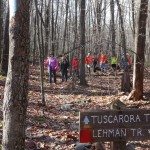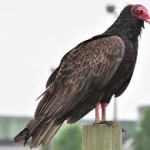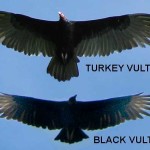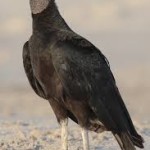- Going Up
- Flat Rock Overlook
- Coming Down
The weather was beautiful for the Flat Rock Hike at Colonel Denning State Park. It was a tough climb but well worth it when we got to see the view. Unfortunately we did not see any Black Vultures since they had already migrated. We did see one Turkey Vulture in migration mode.
On the way back, Sean suggested we loop down the Tuscarora Trail to the Lehman Trail to the wheel where the trails intersect with the Flat Rock Trail down to the trail head. It proved a nice return trip. We also heard Santa’s sleigh bells in the woods which turned out to be a labrador with a bell for hunting season. The dog and its owner were both very friendly.
- Turkey Vulture
- Vulture Silhouettes
- Black Vulture
When at the top of Flat Rock we took a few minutes to discuss the differences between the Black Vulture and Turkey Vulture. The Turkey Vulture being about 30 inches in length, with wingspans up to 6 feet while the Black Vulture is approximately 24 inches in length, with a wingspan less than 5 feet. The Turkey Vulture has a long tail and the Black Vulture has a shorter tail. These differences allow the Turkey Vulture to soar the thermals better than the Black Vulture. A Turkey Vulture holds its wings in a “V” during flight, rarely flaps and wobbles while soaring. The Black Vulture will flap its wings more, does not wobble and holds its wings flat.
Differentiating between the birds’ appearances is easy when you look at the bald heads; the Turkey Vulture having a red head, while the Black Vulture has a black head, with a bone color on the tip of its black beak. It is hard to tell, but the Turkey Vulture is a dark brown and the Black Vulture is “surprisingly” black. Another feature that differentiates the two are the grayish white feathers. The Turkey Vulture has this feature along the back edge of the wings. The Black Vulture has this feature on the wing tips.
Vultures in general are nature’s clean up crew. They eat carrion and will sometimes kill small animals. They have sharp beaks for tearing meat. A question was asked regarding how vultures can eat carrion without getting sick. One hiker was nice enough to look up the answer on the internet. She found that once meat really starts to rot vultures will not eat it. A second defense is a resistanace to most diseases and an extremely acidic stomach. While vultures are given the credit for spreading disease it is now known the opposite is true. They consume sources of disease before it has a chance to spread.
Vultures are gregarious creatures meaning they tend to flock together. These flocks are called kettles. During the breeding season vultures will pair off to raise their young, with both parents taking part in the incubation. Nesting sites include caves, steep cliffs, hollow logs or stumps or dense thickets. Vultures are not great nest builders. Nests consist of the ground, gravel, rotted sawdust or chips in logs and stumps. The Black Vulture makes an extra attempt at nest building by occassionally including bright bits of trash, such as bottle caps and broken glass. The Turkey Vulture lays 1 to 3 eggs that are long oval and dull or creamy white in color. The Black Vulture lays usually 2 eggs which are larger than the Turkey Vulture’s eggs and are a grayish green, bluish-white , or dull white, with btrown blotches and spots.
Now that you know so much about vultures, join us for the December hike on December 21st where we hope to find some animal tracks and signs!

